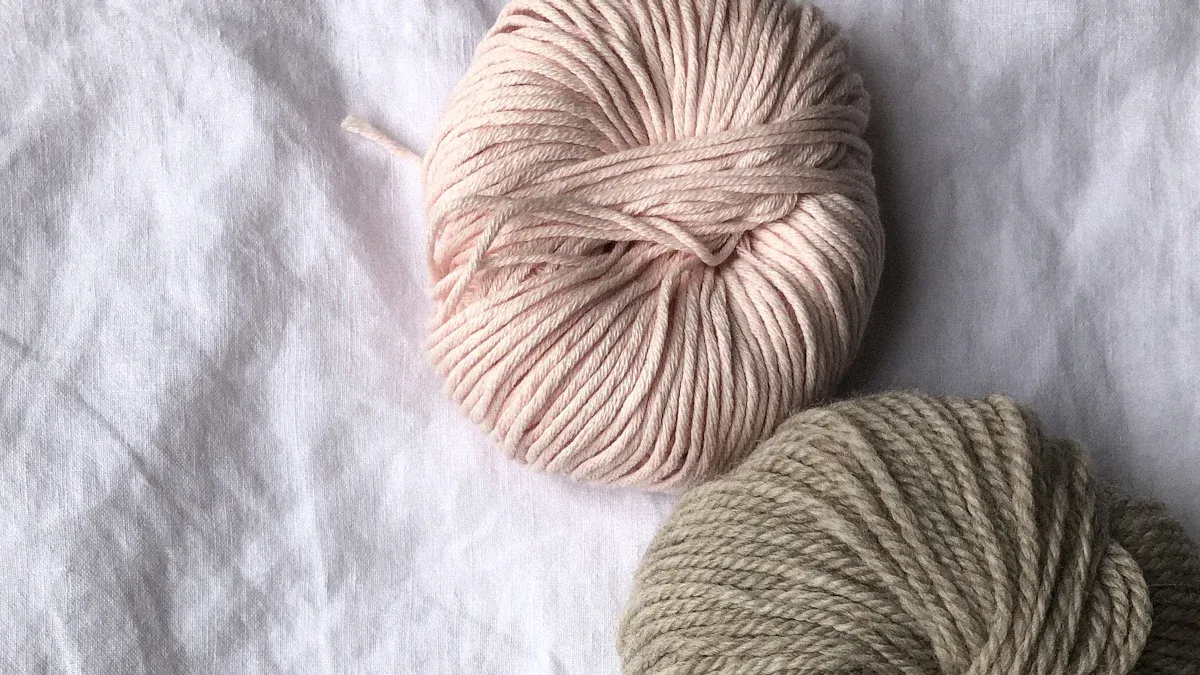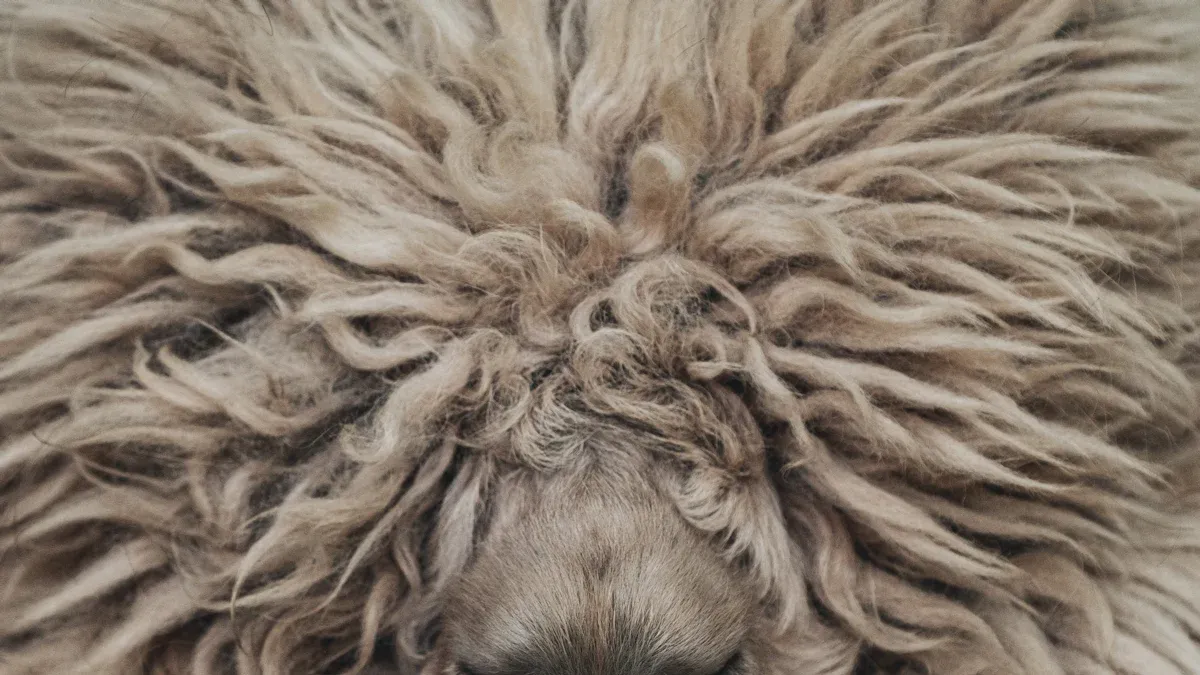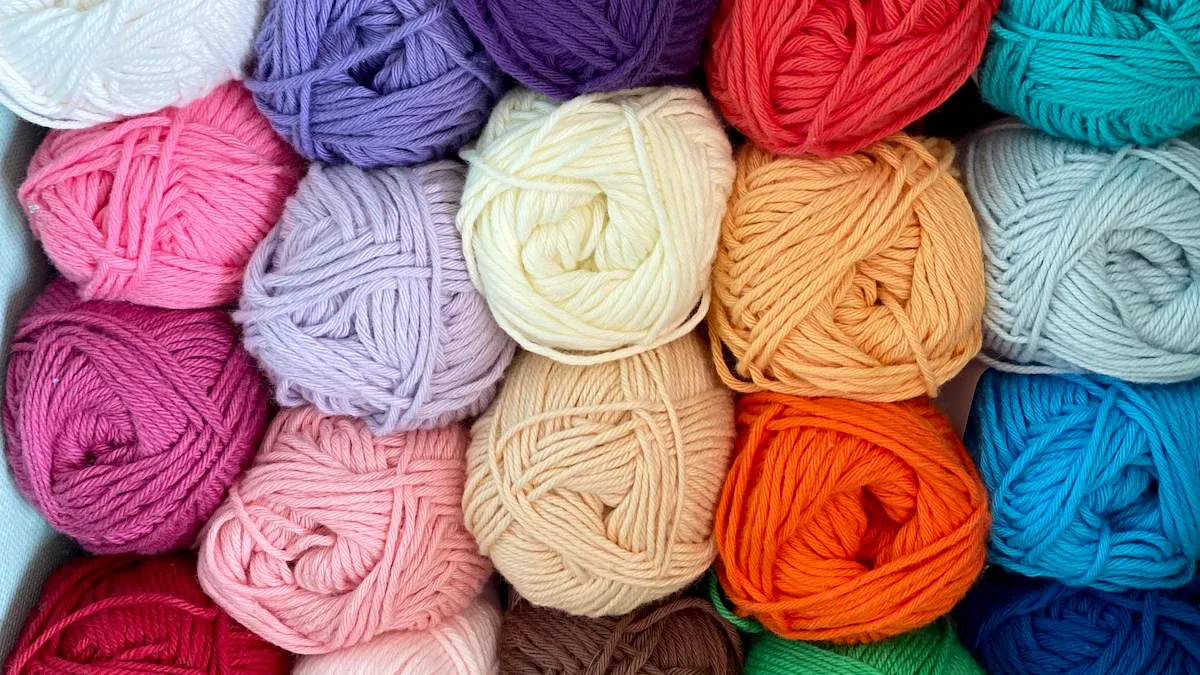
Lana wool fabric is special because it feels smooth and looks nice. Many people like it when they want something different. You might ask what lana means. In many languages, lana just means wool. But when people say lana wool fabric, they mean a certain kind that is high quality. This can be confusing. Sometimes people use wool and lana to mean the same thing. But they are not always the same. Lana wool is made with care. It often comes from Swiss or Italian ways of making fabric. Wool and lana are both popular in fancy markets. Still, wool is only about 1% of all textile fibers in the world. If you look at wool and lana, you will see they feel and look different. People also use them in different ways. Both wool and lana keep you warm. But lana wool fabric has something special.
Key Takeaways
Lana wool fabric feels soft and smooth. It looks fancy because it uses good wool and special weaving.
Lana wool comes from old ways in Switzerland and Italy. It gives warmth, lets air in, and lasts a long time.
Lana wool is finer and softer than regular wool. It is stronger and easier to care for than cashmere.
Lana wool is great for suits, coats, scarves, and home décor. It gives comfort and style all year.
To keep lana wool soft and strong, wash it by hand in cold water. Do not use a machine or treat it roughly.
Lana Wool Fabric Overview

Definition
When you hear the term lana wool, you might think it is just another word for wool. That is not always true. Lana means wool in Spanish and Italian, but when people talk about lana wool fabric, they often mean a special kind of wool fabric. You will notice that lana fabrics stand out because of their smooth feel and fine look. These fabrics use high-quality wool and careful weaving methods. You can find lana wool in many luxury items, from suits to coats. People choose lana when they want something soft, warm, and stylish. Wool and lana both come from sheep, but lana wool fabric often uses finer fibers and advanced techniques. This makes lana fabrics softer and more comfortable than regular wool.
Origins and Development
The story of wool and lana goes back thousands of years. People started choosing sheep with soft, woolly coats around 6000 BC. They wanted better wool for clothing and blankets. By the early 4th millennium BC, woolly sheep spread into Europe. The oldest European wool fabric comes from a Danish bog and dates to about 1500 BC. Back then, people plucked wool by hand or used bronze combs. Later, the Romans made wool popular across their empire. They even bred sheep for the best wool. In medieval times, wool and lana became big business. Fairs in France helped traders sell wool all over Europe. By the 13th century, cities like Florence had guilds that set high standards for lana fabrics.
As time went on, the way people made wool and lana changed. Early workers did everything by hand. They cleaned, spun, and wove wool using simple tools. During the Industrial Revolution, machines took over. Cities like Bradford became famous for making wool and lana fabrics. Today, companies use advanced machines and computer systems. They blend natural fibres with recycled materials to make lana wool fabric even better. Modern lana wool production focuses on quality, sustainability, and style. You get a fabric that feels great and lasts a long time.
Tip: If you want a fabric that mixes tradition with modern comfort, lana wool fabric is a smart choice. It brings together the best of wool and lana.
Wool and Lana: Terminology Explained
Linguistic Differences
You might notice that people use wool and lana in different ways around the world. The word lana comes from Latin and shows up in many languages. In Spanish, lana means wool, but it can also mean money in a casual way. If you travel to Italy, you will hear lana for wool too. In Tagalog, people borrowed lana from Spanish, so it means wool or even a wool garment. Sometimes, you see lana in Hawaiian, but there it means something totally different, like being afloat. Swedish uses lana in a tech sense, not for wool at all. This table helps you see how wool and lana change in meaning:
Language | Origin / Etymology | Meaning(s) | Notes / Usage |
|---|---|---|---|
Spanish | From Latin ‘lāna’ (Romance root) | Wool; colloquially ‘money’ | Semantic extension to ‘cash’ unique to Spanish. |
Latin | Classical Latin ‘lāna’ (first declension) | Wool | Used in classical texts; original source of Romance ‘lana’. |
Tagalog | Borrowed from Spanish ‘lana’ | Wool; wool cloth or garment | Retains original meaning and extends to woolen garments. |
Hawaiian | From Proto-Polynesian langa | Unrelated meaning: ‘be afloat, buoyant’ | Completely different origin and meaning; homograph only. |
Swedish | From LAN (local area network) + suffix | Verb ‘to LAN’ (archaic/dated) | Modern technological origin; unrelated to wool. |
You can see that wool and lana do not always mean the same thing. Sometimes, lana means wool, but not always. If you talk about wool and lana in English, you usually mean two types of fabric. In other languages, you might get a different answer.
Note: When you shop for wool and lana, check the label. You want to make sure you get the fabric you expect.
Material Differences
Now, let’s look at how wool and lana differ as materials. Both come from sheep, but the way people use them is not always the same. Wool is a broad term. It covers all kinds of fibers from sheep. You find wool in sweaters, blankets, and even carpets. Lana, on the other hand, often means a finer, softer fabric. When you see lana on a tag, you know the maker used special care. They picked the best wool fibers and used advanced weaving. This gives lana a smooth touch and a shiny look.
Wool and lana both keep you warm. They both breathe well and feel soft. Still, lana stands out because it feels lighter and smoother. You might pick wool for a cozy sweater. You might choose lana for a sharp suit or a fancy coat. Wool and lana both last a long time if you care for them. Lana needs gentle washing and careful storage. Wool can handle a bit more, but both fabrics like gentle care.
If you ever wonder which to choose, think about how you want to use the fabric. Wool and lana both offer comfort, but lana gives you a touch of luxury. You can enjoy both, but knowing the difference helps you make the best choice.
Types of Wool Fabric Compared

When you look at the different types of wool fabric, you might feel a bit lost. There are so many choices! Let’s break down how lana wool stands out when you compare it to merino, cashmere, and blends. You’ll see how each one brings something special to the table.
Lana Wool vs. Merino
You might wonder if lana wool and merino are the same. They are both popular, but they come from different places and sheep. Lana wool comes from many breeds of sheep all over the world. It is a broad term that covers wool from different regions and types of sheep. Merino, on the other hand, comes only from Merino sheep. These sheep started out in Spain, but now most live in Australia and New Zealand. This makes merino a more specialized type of wool.
When you touch merino, you’ll notice it feels very soft and fine. That’s because Merino sheep produce fibers that are thinner than most other sheep. Lana wool can be soft too, but it depends on the breed and how the fabric is made. If you want a fabric with a clear origin and a reputation for softness, merino is a great pick. If you want something with a wider range of textures and uses, lana wool gives you more options.
Tip: If you care about where your wool comes from, check the label. Merino always comes from Merino sheep, but lana wool can come from many places.
Lana Wool vs. Cashmere
Cashmere feels like a cloud. It comes from goats, not sheep, and the fibers are even finer than merino. When you compare lana wool to cashmere, you’ll notice some big differences. Cashmere is softer and fluffier because the fibers are only 14-19 microns thick. Lana wool, especially if it’s merino, has fibers that are 18-24 microns. That means lana wool is soft, but cashmere is even softer.
Let’s look at how they stack up:
Aspect | Lana Wool (Merino) | Cashmere |
|---|---|---|
Softness | Soft, less itchy than regular wool | Very soft, fluffy, luxurious feel |
Durability | More durable, less pilling | Delicate, prone to pilling |
Maintenance | Machine washable with care | Needs hand washing or dry cleaning |
Cashmere needs gentle care. It can pill and lose its shape if you wash it too much. Lana wool is tougher. You can wash it gently in a machine, and it keeps its shape better. If you want something that lasts and is easy to care for, lana wool is a smart choice. If you want the softest feel and don’t mind extra care, cashmere is for you.
Lana wool is sturdier and more resistant to pilling.
Cashmere needs special care, but can last for years if you treat it well.
Lana Wool vs. Blends
You’ll see lots of blends in the world of wool. Makers mix lana wool with other fibers to change how the fabric feels and works. Some blends use cotton, silk, or synthetic fibers like polyester and nylon. Each blend changes the fabric in a different way.
Here’s a quick look at common blends:
Blend Type | What’s Mixed In | How It Changes the Fabric | Best Uses |
|---|---|---|---|
Pure Lana Wool | 100% wool | Warm, elastic, soft, breathable | Cold weather, classic suits |
Cotton Blends | Cotton | More breathable, lighter, cooler | Spring and fall clothes |
Silk Blends | Silk | Adds shine, smoothness, style | Dressy outfits, scarves |
Polyester/Nylon Blends | Synthetic fibers | Stronger, more elastic, less wrinkling | Socks, uniforms, workwear |
Alpaca/Synthetic Blends | Alpaca or synthetics | Softer, warmer, or more durable, depending on mix | Sweaters, outerwear |
If you pick 100% lana wool, you get the most warmth and breathability. The curled fibers trap air, keeping you cozy. Blends with synthetics make the fabric stronger and less itchy, but you lose a bit of warmth and breathability. Cotton blends feel cooler and work well in mild weather. Silk blends add a fancy shine and smooth touch.
Note: Blends can be great for everyday wear. They last longer and are easier to care for, but pure lana wool fabric gives you the best warmth and classic feel.
What Makes Lana Wool Fabric Unique?
You might ask, “Why choose lana wool over other types of wool fabric?” Here’s what makes it stand out:
Lana wool fabric often comes from Swiss or Italian traditions. Makers focus on quality and design.
The structure is refined. You get a smooth, even surface that feels soft and looks sharp.
Lana wool offers a balance of warmth, breathability, and durability. It works for both classic and modern styles.
You can find lana wool in suits, coats, and luxury items. It’s a favorite for people who want comfort and style.
When you compare all types of wool fabric, you’ll see that lana wool gives you a mix of tradition, quality, and versatility. It’s not just about where it comes from, but how it’s made and how it feels when you wear it.
Features and Uses of Lana Wool Fabric
Texture and Structure
When you touch lana wool fabric, you notice its softness right away. The fine wool fibers give it a delicate and airy texture. This softness makes lana stand out from other fabrics. The structure of lana wool is special because the fibers have a crimped and hollow shape. These tiny air pockets trap air, which boosts the warmth you feel when you wear it. The crimp also helps the fibers lock together, making the fabric strong and long-lasting.
Lana wool does more than just keep you warm. The fibers absorb moisture without feeling wet, so you stay comfortable all day. You also get natural flame resistance, sound absorption, and even some self-cleaning power. The anti-static and odor-resistant qualities mean your clothes stay fresh longer. You can count on lana wool for both softness and durability. It brings you a mix of comfort, warmth, and lasting quality.
Did you know? Lana wool fabric is naturally resistant to stains and odors, so you spend less time worrying about spills and smells.
Common Applications
You see lana wool used in many ways because of its softness and warmth. People love it for luxury suits, stylish coats, and elegant dresses. The smooth surface and high quality make it perfect for clothing that needs to look sharp and feel comfortable. You might find lana wool in scarves, hats, and gloves too. These accessories keep you warm without feeling heavy.
Lana wool also works well in home décor. Designers use it for blankets, throws, and even curtains. Its sound-absorbing and insulating features help make your space cozy and quiet. Some high-end furniture uses lana wool fabric for its softness and durability. You get both beauty and function in one package.
If you care about sustainability, look for lana wool with certifications like the Responsible Wool Standard. This label means the wool comes from farms that treat animals well and protect the environment. You get peace of mind along with top-notch quality.
Care Tips
Taking care of lana wool fabric helps keep its softness and warmth for years. You should always hand-wash lana wool in cold water with mild soap. Never use a washing machine, and avoid wringing or twisting the fabric. After washing, lay it flat on a rack to dry. Shape it back to its original form and keep it away from direct heat.
Care Aspect | What You Should Do |
|---|---|
Washing | Hand-wash in cold water, use mild soap, turn inside out, avoid machine washing |
Drying | Lay flat to dry, reshape, avoid hangers and direct heat, towel-roll to remove water |
Storing | Fold neatly, store in a drawer or shelf, use cotton bags, add lavender for moths |
Stain Removal | Spot-clean with mild soap, avoid rubbing, towel-roll after rinsing |
Pilling Care | Use a lint shaver or sweater stone, brush off debris, avoid friction |
Ironing | Use steam or a damp cloth, avoid direct ironing |
Tip: Wash lana wool only when needed. Too much washing can reduce its softness and warmth. Always follow care labels for the best results.
You now know what sets lana apart from other wool fabrics.
Lana stands out for its Italian roots, soft feel, and careful processing.
Wool and lana both offer warmth, but lana gives you a smoother texture and a touch of luxury.
Wool and lana can look similar, but knowing the difference helps you pick the right fabric.
Wool and lana both need care, but lana needs a gentle touch to keep its shine.
Wool and lana both show up in high-end clothes and home décor.
When you want fabric that is durable, safe, and stylish for your home, lana is the best pick. Wool and lana both have their place, but lana shines when you want comfort and beauty together. Remember, understanding wool and lana helps you make smart choices every time you shop.
FAQ
What is the main difference between lana and regular wool?
You might notice that lana feels softer and smoother than regular wool. Makers use special weaving techniques for lana. Regular wool can feel rougher. Lana often comes from Swiss or Italian traditions. You get a more refined fabric with lana, while wool covers many types and qualities.
Can you wear lana wool fabric in warm weather?
Yes, you can! Lana wool fabric breathes well. It keeps you cool when it’s warm and warm when it’s cold. Wool fibers in lana help move moisture away from your skin. You stay comfortable in different seasons. Many people choose lana for year-round style.
How do you care for lana wool clothing?
You should hand-wash lana wool in cold water. Use mild soap. Never twist or wring the fabric. Lay it flat to dry. Wool and lana both need gentle care. If you follow these steps, your lana wool clothing will stay soft and last longer.
Is lana wool fabric good for people with sensitive skin?
Lana wool fabric works well for sensitive skin. The fine wool fibers in lana feel soft and smooth. You won’t feel itchy like with some other wool fabrics. Many people with skin concerns pick lana for comfort. Always check the label for pure lana wool.
What are the best uses for lana wool fabric?
You can use lana wool for suits, coats, scarves, and even home décor. Wool in lana gives warmth and style. Designers love lana for its smooth look. You get a fabric that works for both fancy and everyday items. Lana wool brings comfort and elegance together.









